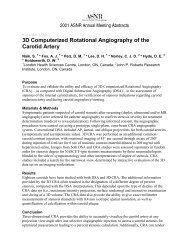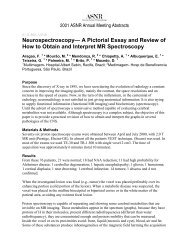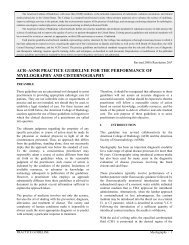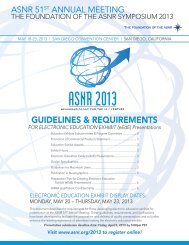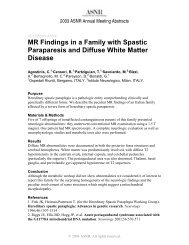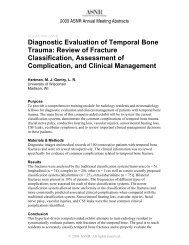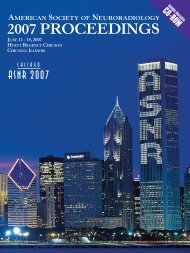acr–asnr–assr–sir–snis practice guideline for the performance of ...
acr–asnr–assr–sir–snis practice guideline for the performance of ...
acr–asnr–assr–sir–snis practice guideline for the performance of ...
- No tags were found...
You also want an ePaper? Increase the reach of your titles
YUMPU automatically turns print PDFs into web optimized ePapers that Google loves.
any new methods <strong>for</strong> achieving <strong>the</strong> same end: vertebralaugmentation.A thorough review <strong>of</strong> <strong>the</strong> literature was per<strong>for</strong>med. Whenpublished data were felt to be inadequate, data from <strong>the</strong>expert panel members’ own quality assurance programswere used to supplement. Thresholds <strong>for</strong> qualityassurance have been updated in accordance with availabledata in <strong>the</strong> literature.Introduced by Galibert and Deramond et al in France in1987 [1], vertebroplasty entails injection <strong>of</strong> material into<strong>the</strong> weakened vertebra. Radiologic imaging has been acritical part <strong>of</strong> vertebroplasty from its inception. Mostprocedures are per<strong>for</strong>med using fluoroscopic guidance <strong>for</strong>needle placement and material injection or placement.The use <strong>of</strong> computed tomography (CT) has also beendescribed <strong>for</strong> <strong>the</strong>se purposes [2-3].Vertebral augmentation is an established and safeprocedure [1-2,4-21]. Two blinded, randomizedcontrolled trials failed to demonstrate an advantage in<strong>the</strong>ir study populations <strong>for</strong> vertebroplasty over a controlintervention <strong>for</strong> ei<strong>the</strong>r pain reduction or disabilityimprovement [22-23]. However, larger, non-blinded,prospective randomized controlled studies and o<strong>the</strong>rstudies <strong>of</strong> vertebral augmentation have shown its efficacy[24-36]. As with any invasive procedure, <strong>the</strong> patient ismost likely to benefit when <strong>the</strong> procedure is per<strong>for</strong>med inan appropriate environment by qualified physicians.These <strong>guideline</strong>s are intended to be used in qualityimprovement programs to assess vertebral augmentationprocedures. The most important processes <strong>of</strong> care are 1)patient selection, 2) per<strong>for</strong>ming <strong>the</strong> procedure, and 3)monitoring <strong>the</strong> patient. The outcome measures orindicators <strong>for</strong> <strong>the</strong>se processes are indications, successrates, and complication rates. Outcome measures areassigned threshold levels.Use <strong>of</strong> o<strong>the</strong>r technologies to treat patients <strong>for</strong> <strong>the</strong> sameindications should yield similar or better success rates andcomplication pr<strong>of</strong>iles.II.DEFINITIONSVertebral augmentation includes all percutaneoustechniques used to achieve internal vertebral bodystabilization.Vertebroplasty is a minimally invasive surgical orinterventional procedure, per<strong>for</strong>med by percutaneouslyinjecting radiopaque bone cement into a painfulosteoporotic or neoplastic compression fracture or apainful vertebral body weakened by any o<strong>the</strong>r etiology.Kyphoplasty is an image-guided percutaneous procedurethat creates a cavity within <strong>the</strong> bone that is <strong>the</strong>n filledwith material.Failure <strong>of</strong> medical <strong>the</strong>rapy is defined as:III.1. For a patient rendered nonambulatory due to painfrom weakened or fractured vertebral body, painpersisting at a level that prevents ambulationdespite 24 hours <strong>of</strong> analgesic <strong>the</strong>rapy.or2. For a patient with sufficient pain from weakenedor fractured vertebral body that physical <strong>the</strong>rapyis intolerable, pain persisting at that level despite24 hours <strong>of</strong> analgesic <strong>the</strong>rapy.or3. For any patient with weakened or fracturedvertebral body, unacceptable side effects such asexcessive sedation, confusion, or constipationdue to <strong>the</strong> analgesic <strong>the</strong>rapy necessary to reducepain to a tolerable level.OVERVIEWVertebral compression fractures are a common and <strong>of</strong>tendebilitating complication <strong>of</strong> osteoporosis [37-41].Although most fractures heal within a few weeks ormonths, a minority <strong>of</strong> patients continue to suffer pain thatdoes not respond to conservative <strong>the</strong>rapy [42-44].Vertebral compression fractures are a leading cause <strong>of</strong>nursing home admission. Open surgical fixation is rarelyused to treat <strong>the</strong>se fractures. The poor quality <strong>of</strong> bone at<strong>the</strong> adjacent unfractured levels does not provide a goodanchor <strong>for</strong> surgical hardware, and <strong>the</strong> advanced age <strong>of</strong>most affected patients increases <strong>the</strong> morbidity andmortality risks <strong>of</strong> major surgery.Initial success with vertebroplasty <strong>for</strong> treating aggressivehemangiomas [1,12] and osteolytic neoplasms [10,21] ledto extension <strong>of</strong> <strong>the</strong> indications to include osteoporoticcompression fractures refractory to medical <strong>the</strong>rapy [2,4-9,11,13-19]. Vertebral augmentation is currently beingused to treat a wide variety <strong>of</strong> osteolytic metastases andmultiple myelomas.Perioperative imaging that identifies <strong>the</strong> painful vertebralbody in concordance with <strong>the</strong> clinical examination isconsidered essential <strong>for</strong> <strong>the</strong> safe and effectiveper<strong>for</strong>mance <strong>of</strong> vertebral augmentation.IV.INDICATIONS ANDCONTRAINDICATIONSThe major indication <strong>for</strong> vertebral augmentation is <strong>the</strong>treatment <strong>of</strong> symptomatic osteoporotic vertebral bodyfracture(s) refractory to medical <strong>the</strong>rapy or vertebralbodies weakened due to neoplasia. Currently, <strong>the</strong>re is noindication <strong>for</strong> <strong>the</strong> use <strong>of</strong> vertebral augmentation <strong>for</strong>2 / Vertebral Augmentation PRACTICE GUIDELINE
prophylaxis against future fracture. The indications andcontraindications <strong>for</strong> vertebral augmentation may changein <strong>the</strong> future as more research and in<strong>for</strong>mation becomeavailable.A. Indication Threshold 95%1. Painful osteoporotic vertebral fracture(s)refractory to medical <strong>the</strong>rapy.2. Vertebral bodies weakened by neoplasm.3. Symptomatic vertebral body micr<strong>of</strong>racture (asdocumented by magnetic resonance imaging[MRI] or nuclear imaging, and/or lytic lesionseen on computed tomography (CT) withoutobvious loss <strong>of</strong> vertebral body height.When fewer than 95% <strong>of</strong> vertebral augmentations in aninstitution are per<strong>for</strong>med <strong>for</strong> <strong>the</strong> above indications, itshould prompt a review <strong>of</strong> <strong>practice</strong>s related to selection <strong>of</strong>patients <strong>for</strong> this procedure.B. Absolute Contraindications1. Septicemia.2. Active osteomyelitis <strong>of</strong> <strong>the</strong> target vertebra.3. Uncorrectable coagulopathy.4. Allergy to bone cement or opacification agent.C. Relative Contraindications1. Radiculopathy in excess <strong>of</strong> local vertebral pain,caused by a compressive syndrome unrelated tovertebral collapse. Occasionally preoperativevertebroplasty can be per<strong>for</strong>med be<strong>for</strong>e a spinaldecompressive procedure.2. Retropulsion <strong>of</strong> a fracture fragment causingsevere spinal canal compromise.3. Epidural tumor extension with significantencroachment on <strong>the</strong> spinal canal.4. Ongoing systemic infection.5. Patient improving on medical <strong>the</strong>rapy.6. Prophylaxis in osteoporotic patients (unlessbeing per<strong>for</strong>med as part <strong>of</strong> a research protocol).7. Myelopathy originating at <strong>the</strong> fracture level.V. QUALIFICATIONS ANDRESPONSIBILITIES OF PERSONNELA. PhysicianIn general, <strong>the</strong> requirements <strong>for</strong> physicians per<strong>for</strong>mingvertebral augmentation may be met by adhering to <strong>the</strong>recommendations listed below:1. Certification in Radiology or DiagnosticRadiology by <strong>the</strong> American Board <strong>of</strong> Radiology,<strong>the</strong> American Osteopathic Board <strong>of</strong> Radiology,<strong>the</strong> Royal College <strong>of</strong> Physicians and Surgeons <strong>of</strong>Canada, or <strong>the</strong> Collège des Médecins du Québec,and must include per<strong>for</strong>mance <strong>of</strong> successfulvertebral augmentation procedures in at least 5patients as <strong>the</strong> primary operator, under <strong>the</strong>supervision <strong>of</strong> a qualified physician, and withoutmajor complications.or2. Completion <strong>of</strong> an approved residency orfellowship program by <strong>the</strong> Accreditation Council<strong>for</strong> Graduate Medical Education (ACGME), <strong>the</strong>Royal College <strong>of</strong> Physicians and Surgeons <strong>of</strong>Canada (RCPSC), <strong>the</strong> Collège des Médecins duQuébec, or an American Osteopathic Association(AOA) approved residency program thatincluded 6 months <strong>of</strong> training in cross-sectionalimaging, including CT and MR imaging, and 4months <strong>of</strong> training in image-guidedinterventional radiological techniques, includingvertebral augmentation, biopsy and drainageprocedures, and vascular embolization. Thismust include per<strong>for</strong>mance <strong>of</strong> successful vertebralaugmentations in at least 5 patients as <strong>the</strong>primary operator, under <strong>the</strong> supervision <strong>of</strong> aqualified physician, and without majorcomplications.or3. A physician who did not successfully completean ACGME approved radiology residency orfellowship program that included <strong>the</strong> above maystill be considered qualified to per<strong>for</strong>m vertebralaugmentation provided <strong>the</strong> following can bedemonstrated: <strong>the</strong> physician must have at least 1year <strong>of</strong> experience in per<strong>for</strong>ming percutaneousimage-guided spine procedures, during which <strong>the</strong>physician was supervised by a physician withactive privileges in <strong>the</strong>se spine procedures.During this year he or she must have per<strong>for</strong>med aminimum <strong>of</strong> 5 vertebral augmentations asprimary operator with outcomes within <strong>the</strong>quality improvement thresholds <strong>of</strong> this <strong>guideline</strong>.and4. Physicians meeting any <strong>of</strong> <strong>the</strong> qualifications in 1,2, or 3 above must have written substantiationthat <strong>the</strong>y are familiar with all <strong>of</strong> <strong>the</strong> following:a. Indications and contraindications <strong>for</strong>vertebral augmentation.b. Periprocedural and intraproceduralassessment, monitoring, and management <strong>of</strong><strong>the</strong> patient, and particularly <strong>the</strong> recognitionand initial management <strong>of</strong> proceduralcomplications.c. Appropriate use and operation <strong>of</strong>fluoroscopic and radiographic equipment,digital subtraction systems, and o<strong>the</strong>relectronic imaging systems.d. Principles <strong>of</strong> radiation protection, hazards <strong>of</strong>radiation exposure to <strong>the</strong> patient and <strong>the</strong>PRACTICE GUIDELINE Vertebral Augmentation / 3
adiologic personnel, and radiationmonitoring requirements.e. Anatomy, physiology, and pathophysiology<strong>of</strong> <strong>the</strong> spine, spinal cord, and nerve roots.f. Pharmacology <strong>of</strong> contrast agents andimplanted materials and recognition andtreatment <strong>of</strong> potential adverse reactions to<strong>the</strong>se substances.g. Technical aspects <strong>of</strong> per<strong>for</strong>ming thisprocedure.The written substantiation should come from <strong>the</strong>chief <strong>of</strong> interventional radiology, <strong>the</strong> chief <strong>of</strong>neuroradiology, <strong>the</strong> chief <strong>of</strong> interventionalneuroradiology, or <strong>the</strong> chair <strong>of</strong> <strong>the</strong> department <strong>of</strong><strong>the</strong> institution in which <strong>the</strong> physician will beproviding <strong>the</strong>se services 1 . Substantiation couldalso come from a prior institution in which <strong>the</strong>physician provided <strong>the</strong> services, but only at <strong>the</strong>discretion <strong>of</strong> <strong>the</strong> current interventional,Neurointerventional, or neuroradiology chief, or<strong>the</strong> chair who solicits <strong>the</strong> additional input.and5. Physicians must possess certain fundamentalknowledge and skills that are required <strong>for</strong> <strong>the</strong>appropriate application and safe per<strong>for</strong>mance <strong>of</strong>vertebral augmentation:a. In addition to a basic understanding <strong>of</strong>spinal anatomy, physiology, andpathophysiology, <strong>the</strong> physician must havesufficient knowledge <strong>of</strong> <strong>the</strong> clinical andimaging evaluation <strong>of</strong> patients with spinaldisorders to determine those <strong>for</strong> whomvertebral augmentation is indicated.b. The physician must fully appreciate <strong>the</strong>benefits and risks <strong>of</strong> vertebral augmentationand <strong>the</strong> alternatives to <strong>the</strong> procedure.c. The physician is required to be competent in<strong>the</strong> use <strong>of</strong> fluoroscopy, CT, and MRI orinterpretation <strong>of</strong> images in <strong>the</strong> modalitiesused to evaluate potential patients and guide<strong>the</strong> vertebral augmentation procedure.d. The physician should be able to recognize,interpret, and act immediately on imagefindings.e. The physician must have <strong>the</strong> ability, skills,and knowledge to evaluate <strong>the</strong> patient’sclinical status and to identify those patientswho might be at increased risk, who mayrequire additional perioperative care, or whohave relative contraindications to <strong>the</strong>procedure.1 At institutions in which <strong>the</strong>re is joint (dual) credentialingacross departments doing like procedures, this substantiation <strong>of</strong>experience should be done by <strong>the</strong> chairs <strong>of</strong> both departments toensure equity <strong>of</strong> experience among practitioners when <strong>the</strong>irtraining backgrounds differ [43].f. The physician must be capable <strong>of</strong> providing<strong>the</strong> initial clinical management <strong>of</strong>complications <strong>of</strong> vertebral augmentation,including administration <strong>of</strong> basic lifesupport, treatment <strong>of</strong> pneumothorax, andrecognition <strong>of</strong> spinal cord compression.g. Training in radiation physics and safety is animportant component <strong>of</strong> <strong>the</strong>se requirements.Such training is important to maximize bothpatient and physician safety. It is highlyrecommended that <strong>the</strong> physician haveadequate training in and be familiar with <strong>the</strong>principles <strong>of</strong> radiation exposure, <strong>the</strong> hazards<strong>of</strong> radiation exposure to both patients andradiologic personnel, and <strong>the</strong> radiationmonitoring requirements <strong>for</strong> <strong>the</strong> imagingmethods listed above.Some methods <strong>of</strong> vertebral augmentation may requirespecialized training and experience, and such needsshould be assessed be<strong>for</strong>e a physician contemplates usingany method.Maintenance <strong>of</strong> CompetencePhysicians should per<strong>for</strong>m a sufficient number <strong>of</strong>vertebral augmentation procedures to maintain <strong>the</strong>ir skills,with acceptable success and complication rates as laid outin this <strong>guideline</strong>. Continued competence depends onparticipation in a quality improvement program thatmonitors <strong>the</strong>se rates. Regular attendance at postgraduatecourses that provide continuing education on diagnosticand technical advances in vertebral augmentation isnecessary.Continuing Medical EducationThe physician’s continuing education should be inaccordance with <strong>the</strong> ACR Practice Guideline <strong>for</strong>Continuing Medical Education (CME).B. Nonphysician PractitionersPhysician assistants and nurse practitioners can bevaluable members <strong>of</strong> <strong>the</strong> interventional radiology teambut not as primary operator. These nonphysicianpractitioners can function as independent members <strong>of</strong> <strong>the</strong>team but not as primary operator. See <strong>the</strong> ACR–SIR–SNIS Practice Guideline <strong>for</strong> Interventional ClinicalPractice.C. Qualified Medical PhysicistA Qualified Medical Physicist is an individual who iscompetent to <strong>practice</strong> independently one or more <strong>of</strong> <strong>the</strong>subfields in medical physics. The American College <strong>of</strong>Radiology (ACR) considers certification, continuingeducation, and experience in <strong>the</strong> appropriate subfield(s) to4 / Vertebral Augmentation PRACTICE GUIDELINE
demonstrate that an individual is competent to <strong>practice</strong>one or more <strong>of</strong> <strong>the</strong> subfields in medical physics and to bea Qualified Medical Physicist. The ACR stronglyrecommends that <strong>the</strong> individual be certified in <strong>the</strong>appropriate subfield(s) by <strong>the</strong> American Board <strong>of</strong>Radiology (ABR), <strong>the</strong> Canadian College <strong>of</strong> Physics inMedicine, or <strong>the</strong> American Board <strong>of</strong> Medical Physics(ABMP).The appropriate subfield in medical physics <strong>for</strong> this<strong>guideline</strong> is Diagnostic Medical Physics. (Previousmedical physics certification categories includingRadiological Physics, Diagnostic Radiological Physics,and Diagnostic Imaging Physics are also acceptable.)A Qualified Medical Physicist should meet <strong>the</strong> ACRPractice Guideline <strong>for</strong> Continuing Medical Education(CME). (ACR Resolution 17, 1996 – revised in 2012,Resolution 42)D. Registered Radiologist AssistantA registered radiologist assistant is an advanced levelradiographer who is certified and registered as aradiologist assistant by <strong>the</strong> American Registry <strong>of</strong>Radiologic Technologists (ARRT) after havingsuccessfully completed an advanced academic programencompassing an ACR/ASRT (American Society <strong>of</strong>Radiologic Technologists) radiologist assistant curriculumand a radiologist-directed clinical preceptorship. Underradiologist supervision, <strong>the</strong> radiologist assistant mayper<strong>for</strong>m patient assessment, patient management andselected examinations as delineated in <strong>the</strong> Joint PolicyStatement <strong>of</strong> <strong>the</strong> ACR and <strong>the</strong> ASRT titled “RadiologistAssistant: Roles and Responsibilities” and as allowed bystate law. The radiologist assistant transmits to <strong>the</strong>supervising radiologists those observations that have abearing on diagnosis. Per<strong>for</strong>mance <strong>of</strong> diagnosticinterpretations remains outside <strong>the</strong> scope <strong>of</strong> <strong>practice</strong> <strong>of</strong> <strong>the</strong>radiologist assistant. (ACR Resolution 34, adopted in2006)E. Radiologic TechnologistThe technologist, toge<strong>the</strong>r with <strong>the</strong> physician and <strong>the</strong>nursing personnel, should be responsible <strong>for</strong> patientcom<strong>for</strong>t. The technologist should be able to prepare andposition <strong>the</strong> patient <strong>for</strong> <strong>the</strong> vertebral augmentationprocedure and, toge<strong>the</strong>r with <strong>the</strong> nurse, monitor <strong>the</strong>patient during <strong>the</strong> procedure. The technologist shouldobtain <strong>the</strong> imaging data in a manner prescribed by <strong>the</strong>supervising physician. The technologist should alsoper<strong>for</strong>m regular quality control testing <strong>of</strong> <strong>the</strong> equipmentunder <strong>the</strong> supervision <strong>of</strong> <strong>the</strong> Qualified Medical Physicist.The technologist should have appropriate training andexperience in <strong>the</strong> vertebral augmentation procedure andbe certified by <strong>the</strong> American Registry <strong>of</strong> RadiologicTechnologists (ARRT) and/or have an unrestricted statelicense.F. Nursing ServicesNursing services are an integral part <strong>of</strong> <strong>the</strong> team <strong>for</strong>perioperative patient management and education and mayassist <strong>the</strong> physician in monitoring <strong>the</strong> patient during <strong>the</strong>vertebral augmentation procedure.VI.SPECIFICATIONS OF THE PROCEDUREA. Technical RequirementsVertebral augmentation may be per<strong>for</strong>med with ei<strong>the</strong>rfluoroscopy or CT imaging guidance. The choice is amatter <strong>of</strong> operator preference and patient characteristics.In ei<strong>the</strong>r case, <strong>the</strong>re are several technical requirements toensure safe and successful vertebral augmentations. Theseinclude adequate institutional facilities, imaging andmonitoring equipment, and support personnel. Thefollowing are minimum requirements <strong>for</strong> any institutionin which vertebral augmentation is to be per<strong>for</strong>med:1. A procedural suite large enough to allow safeand easy transfer <strong>of</strong> <strong>the</strong> patient from bed toprocedural table with sufficient space <strong>for</strong>appropriate positioning <strong>of</strong> patient monitoringequipment, anes<strong>the</strong>sia equipment, respirators,etc. There should be adequate space <strong>for</strong> <strong>the</strong>operating team to work unencumbered on ei<strong>the</strong>rside <strong>of</strong> <strong>the</strong> patient and <strong>for</strong> <strong>the</strong> circulation <strong>of</strong> o<strong>the</strong>rstaff within <strong>the</strong> room without contaminating <strong>the</strong>sterile conditions.2. The majority <strong>of</strong> <strong>the</strong>se procedures are per<strong>for</strong>medunder fluoroscopic guidance. A high-resolutionimage intensifier or flat-panel detector and videosystem with adequate shielding, capable <strong>of</strong> rapidimaging in orthogonal planes, and withcapabilities <strong>for</strong> permanent image recording isstrongly recommended. The fluoroscope shouldbe compliant with IEC 601-2-43 [45]. Imagingfindings are acquired and stored ei<strong>the</strong>r onconventional film or digitally on computerizedstorage media. Imaging and image recordingmust be consistent with <strong>the</strong> as-low-asreasonably-achievable(ALARA) radiation safety<strong>guideline</strong>s.3. Immediate access to CT and rapid (within 30 or45 minutes) access to MRI is necessary toevaluate potential complications. This may beparticularly important if vertebral augmentationis planned in patients with osteolytic vertebralmetastasis and/or with significant pre-existingspinal canal compromise.PRACTICE GUIDELINE Vertebral Augmentation / 5
4. The facility must provide adequate resources <strong>for</strong>observing patients during and after vertebralaugmentation. Physiologic monitoring devicesappropriate to <strong>the</strong> patient’s needs – includingblood pressure monitoring, pulse oximetry, andelectrocardiography – and equipment <strong>for</strong>cardiopulmonary resuscitation must be availablein <strong>the</strong> procedural suite.B. Surgical and Emergency SupportAlthough serious complications <strong>of</strong> vertebral augmentationare infrequent, <strong>the</strong>re should be prompt access to surgical,interventional, and medical management <strong>of</strong>complications.C. Patient Care1. Preprocedural carea. The clinical history and findings, including<strong>the</strong> indications <strong>for</strong> <strong>the</strong> procedure, must bereviewed and recorded in <strong>the</strong> patient’smedical record by <strong>the</strong> physician per<strong>for</strong>ming<strong>the</strong> procedure. Specific inquiry should bemade with respect to relevant medications,prior allergic reactions, and bleeding/clotting status.b. The vital signs and <strong>the</strong> results <strong>of</strong> physicaland neurological examinations must beobtained and recorded.c. The indication(s) <strong>for</strong> <strong>the</strong> procedure,including (if applicable) documentation <strong>of</strong>failed medical <strong>the</strong>rapy, must be recorded.d. The indication(s) <strong>for</strong> treatment <strong>of</strong> <strong>the</strong>fracture should have documentation <strong>of</strong>imaging correlation and confirmation.2. Procedural carea. Adherence to <strong>the</strong> Joint Commission’scurrent Universal Protocol <strong>for</strong> PreventingWrong Site, Wrong Procedure, WrongPerson Surgery is required <strong>for</strong> proceduresin non-operating room settings includingbedside procedures.The organization should have processes andsystems in place <strong>for</strong> reconciling differencesin staff responses during <strong>the</strong> “time out.”b. Vital signs should be obtained at regularintervals during <strong>the</strong> course <strong>of</strong> <strong>the</strong> procedure,and a record <strong>of</strong> <strong>the</strong>se measurements shouldbe maintained.c. Patients undergoing vertebral augmentationmust have intravenous access in place <strong>for</strong><strong>the</strong> administration <strong>of</strong> fluids and medicationsas needed.d. If <strong>the</strong> patient receives sedation, pulseoximetry must be used. Administration <strong>of</strong>VII.sedation <strong>for</strong> vertebral augmentation shouldbe in accordance with <strong>the</strong> ACR–SPRPractice Guideline <strong>for</strong> Sedation/Analgesia.A registered nurse or o<strong>the</strong>r appropriatelytrained personnel should be present and haveprimary responsibility <strong>for</strong> monitoring <strong>the</strong>patient. A record <strong>of</strong> medication doses andtimes <strong>of</strong> administration should bemaintained.3. Postprocedural carea. A procedural note should be written in <strong>the</strong>patient’s medical record summarizing <strong>the</strong>course <strong>of</strong> <strong>the</strong> procedure and what wasaccomplished, any immediatecomplications, and <strong>the</strong> patient’s status at <strong>the</strong>conclusion <strong>of</strong> <strong>the</strong> procedure (see sectionVIII.A.2 below). This note may be brief if<strong>the</strong> <strong>for</strong>mal report will be available within afew hours. This in<strong>for</strong>mation should becommunicated to <strong>the</strong> referring physician in atimely manner. A more detailed summary <strong>of</strong><strong>the</strong> procedure should be written in <strong>the</strong>medical record if <strong>the</strong> <strong>for</strong>mal typed reportwill not be on <strong>the</strong> medical record within <strong>the</strong>same day.b. All patients should be at bed rest andobserved during <strong>the</strong> initial postproceduralperiod. The length <strong>of</strong> this period will dependon <strong>the</strong> patient’s medical condition.c. During <strong>the</strong> immediate postproceduralperiod, skilled nurses or o<strong>the</strong>r appropriatelytrained personnel should monitor <strong>the</strong>patient’s vital signs, urinary output,sensorium, and motor strength. Neurologicalstatus should be assessed frequently atregular intervals. Initial ambulation <strong>of</strong> <strong>the</strong>patient must be carefully supervised.d. The operating physician or a qualifieddesignee (ano<strong>the</strong>r physician or a nurse)should evaluate <strong>the</strong> patient after <strong>the</strong> initialpostprocedural period, and <strong>the</strong>se findingsshould be summarized in a progress note on<strong>the</strong> patient’s medical record. The physicianor designee must be available <strong>for</strong> continuingcare during hospitalization and afterdischarge.EQUIPMENT QUALITY CONTROLEach facility should have documented policies andprocedures <strong>for</strong> monitoring and evaluating <strong>the</strong> effectivemanagement, safety, and proper per<strong>for</strong>mance <strong>of</strong> imagingand interventional equipment. The quality controlprogram should be designed to maximize <strong>the</strong> quality <strong>of</strong><strong>the</strong> diagnostic in<strong>for</strong>mation. This may be accomplished aspart <strong>of</strong> a routine preventive maintenance program.6 / Vertebral Augmentation PRACTICE GUIDELINE
VIII.QUALITY IMPROVEMENT ANDDOCUMENTATIONA. DocumentationResults <strong>of</strong> vertebral augmentation procedures should bemonitored on a continuous basis. Records should be kept<strong>of</strong> both immediate and long-term results andcomplications. The number <strong>of</strong> complications should bedocumented. Any biopsies per<strong>for</strong>med in conjunction withvertebral augmentation should be followed up to detectand record any false negative and false positive results.A permanent record <strong>of</strong> vertebral augmentation proceduresshould be maintained in a retrievable image storage<strong>for</strong>mat.1. Imaging labeling should include permanentidentification containing:a. Facility name and location.b. Examination date.c. Patient’s first and last names.d. Patient’s identification number and/or date<strong>of</strong> birth.2. The initial progress note and final report shouldinclude:a. Procedure undertaken and its purpose.b. Type <strong>of</strong> anes<strong>the</strong>sia used (local, moderate,deep or general).c. Listing <strong>of</strong> level(s) treated and amount <strong>of</strong>cement injected at each level.d. Evaluation <strong>of</strong> injection site and focusedneurologic examination.e. Immediate complications, if any, includingtreatment and outcome.f. Radiation dose estimate (or fluoroscopytime and <strong>the</strong> number <strong>of</strong> images obtained onequipment that does not provide directdosimetry in<strong>for</strong>mation) [46-48].3. Follow up documentation:a. Postprocedure evaluation to assess patientresponse (pain relief, mobilityimprovement). Standardized assessmenttools such as <strong>the</strong> SF 36 and <strong>the</strong> Roland-Morris disability scale may be useful <strong>for</strong>both preoperative and postoperative patientevaluation.b. Evaluation <strong>of</strong> injection site and focusedneurologic examination.c. Delayed complications, if any, includingtreatment and outcome.d. Pathology (biopsy) results, if any.e. Record <strong>of</strong> communications with patient andreferring physician.f. Patient disposition.Reporting should be in accordance with <strong>the</strong> ACR–SIRPractice Guideline <strong>for</strong> <strong>the</strong> Reporting and Archiving <strong>of</strong>Interventional Radiology Procedures.B. In<strong>for</strong>med Consent and Procedural RiskIn<strong>for</strong>med consent or emergency administrative consentmust be obtained and must comply with <strong>the</strong> ACR–SIRPractice Guideline on In<strong>for</strong>med Consent <strong>for</strong> Image-Guided Procedures [49]. Risks cited should includeinfection; bleeding; allergic reaction; rib or vertebralfracture; vessel injury; pneumothorax (<strong>for</strong> appropriatelevels); and implanted material displacement into <strong>the</strong>adjacent epidural or paravertebral veins resulting inworsening pain or paralysis, spinal cord or nerve injury,or pulmonary complication. The potential need <strong>for</strong>immediate surgical intervention should be discussed. Thepossibility that <strong>the</strong> patient may not experience significantpain relief should also be discussed.C. Success and Complication Rates and Thresholds [1-2,4-21]Although practicing physicians should strive to achieveperfect outcomes (e.g., 100% success, 0% complications),in <strong>practice</strong>, all physicians will fall short <strong>of</strong> this ideal to avariable extent. There<strong>for</strong>e, indicator thresholds may beused to assess <strong>the</strong> efficacy <strong>of</strong> ongoing qualityimprovement programs. For <strong>the</strong> purposes <strong>of</strong> <strong>the</strong>se<strong>guideline</strong>s, a threshold is a specific level <strong>of</strong> an indicatorthat should prompt a review. Procedure thresholds oroverall thresholds refer to a group <strong>of</strong> indicators <strong>for</strong> aprocedure, e.g., major complications. Individualcomplications may also be associated with complicationspecificthresholds. When measures such as indications orsuccess rates fall below a minimum threshold, or whencomplication rates exceed a maximum threshold, a reviewshould be per<strong>for</strong>med to determine causes and toimplement changes if necessary. For example, if <strong>the</strong>incidence <strong>of</strong> fracture <strong>of</strong> rib or o<strong>the</strong>r bone is one measure<strong>of</strong> <strong>the</strong> quality <strong>of</strong> vertebral augmentation, values in excess<strong>of</strong> <strong>the</strong> defined threshold (in this case
<strong>the</strong>rapy (<strong>for</strong> outpatient procedures), an unplanned increasein <strong>the</strong> level <strong>of</strong> care, prolonged hospitalization, permanentadverse sequelae, or death. Minor complications result inno sequelae, but may require nominal <strong>the</strong>rapy or a shorthospital stay <strong>for</strong> observation (generally overnight; seeAppendix A). The complication rates and thresholdsdescribed herein refer to major complications.Routine periodic review <strong>of</strong> all cases having less thanperfect outcomes is strongly encouraged. Seriouscomplications <strong>of</strong> vertebral augmentation are infrequent. Areview is <strong>the</strong>re<strong>for</strong>e recommended <strong>for</strong> all instances <strong>of</strong>death, infection, or symptomatic pulmonary embolus.Table 1: Vertebral Augmentation Success Rates [51-58]Success RatesWhen vertebral augmentation is per<strong>for</strong>med <strong>for</strong>osteoporosis, procedure outcomes can be defined using<strong>the</strong> criteria by Hodler et al [50] with patients categorizedas worse, same, better, or pain/disability gone. For <strong>the</strong>purpose <strong>of</strong> this document pain/disability gone is definedas improved. There<strong>for</strong>e patients should be categorized asei<strong>the</strong>r improved, <strong>the</strong> same, or worse. This categorizationshould be determined with <strong>the</strong> use <strong>of</strong> a validatedmeasurement tool.When vertebral augmentation is per<strong>for</strong>med <strong>for</strong> neoplasticinvolvement, success is defined as achievement <strong>of</strong>significant pain relief and/or improved mobility asmeasured by validated measurement tools.Published Success Rates Threshold <strong>for</strong> ReviewNeoplastic, all causes 70% to 92% 10%Permanent neurological deficit (within 30 days <strong>of</strong><strong>the</strong> procedure or requiring surgery)OsteoporosisNeoplasm1%>5%Fracture <strong>of</strong> rib, sternum or vertebra 1% >2%Allergic or idiosyncratic reaction 1%Infection 0%Symptomatic pulmonary material embolus 0%Significant hemorrhage or vascular injury 0%Symptomatic hemothorax or pneumothorax 0%Death 0%The overall procedure threshold <strong>for</strong> all complications resulting from vertebral augmentation per<strong>for</strong>med <strong>for</strong> osteoporosis is2%, and when per<strong>for</strong>med <strong>for</strong> neoplastic indications it is 10%.8 / Vertebral Augmentation PRACTICE GUIDELINE
IX.RADIATION SAFETY IN IMAGINGRadiologists, medical physicists, radiologic technologists,and all supervising physicians have a responsibility tominimize radiation dose to individual patients, to staff,and to society as a whole, while maintaining <strong>the</strong> necessarydiagnostic image quality. This concept is known as “aslow as reasonably achievable (ALARA).”Facilities, in consultation with <strong>the</strong> medical physicist,should have in place and should adhere to policies andprocedures, in accordance with ALARA, to varyexamination protocols to take into account patient bodyhabitus, such as height and/or weight, body mass index orlateral width. The dose reduction devices that areavailable on imaging equipment should be active; if not;manual techniques should be used to moderate <strong>the</strong>exposure while maintaining <strong>the</strong> necessary diagnosticimage quality. Periodically, radiation exposures should bemeasured and patient radiation doses estimated by amedical physicist in accordance with <strong>the</strong> appropriate ACRTechnical Standard. (ACR Resolution 17, adopted in2006 – revised in 2009, Resolution 11.)X. QUALITY CONTROL ANDIMPROVEMENT, SAFETY, INFECTIONCONTROL, AND PATIENT EDUCATIONPolicies and procedures related to quality, patienteducation, infection control, and safety should bedeveloped and implemented in accordance with <strong>the</strong> ACRPolicy on Quality Control and Improvement, Safety,Infection Control, and Patient Education appearing under<strong>the</strong> heading Position Statement on QC & Improvement,Safety, Infection Control, and Patient Education on <strong>the</strong>ACR web site (http://www.acr.org/<strong>guideline</strong>s).ACKNOWLEDGEMENTSThis <strong>guideline</strong> was revised according to <strong>the</strong> processdescribed under <strong>the</strong> heading The Process <strong>for</strong> DevelopingACR Practice Guidelines and Technical Standards on <strong>the</strong>ACR web site (http://www.acr.org/<strong>guideline</strong>s) by <strong>the</strong>Guidelines and Standards Committees <strong>of</strong> <strong>the</strong> Commissionon Neuroradiology and <strong>the</strong> Commission on Interventionaland Cardiovascular Radiology in collaboration with <strong>the</strong>ASNR, <strong>the</strong> ASSR, <strong>the</strong> SIR, and <strong>the</strong> SNIS.Collaborative Committee – members represent <strong>the</strong>irsocieties in <strong>the</strong> initial and final revision <strong>of</strong> this <strong>guideline</strong>.ACRJoshua A. Hirsch, MD, FACR, ChairJohn E. Jordan, MDPhilip M. Meyers, MDJohn D. Statler, MDASNRDavid F. Kallmes, MDJerry G. Jarvik, MDASSRDmitry Niman, MDDan L. Nguyen, MDR. Sean Pakbaz, MDKent B. Remley, MDMichael I. Rothman, MDSIRJohn D. Barr, MDJ. Kevin McGraw, MDSNISAllan L. Brook, MDMary (Lee) Jensen, MDAlbert J. Yoo, MDGuidelines and Standards Committee – Interventional –ACR Committee responsible <strong>for</strong> sponsoring <strong>the</strong> draftthrough <strong>the</strong> processDonald L. Miller, MD, Chair, FACRAradhana M. Venkatesan, MD, Vice-ChairStephen Balter, PhD, FACRRobert G. Dixon, MDLawrence T. Dauer, PhDJoshua A. Hirsch, MD, FACRSanjoy Kundu, MDPhilip M. Meyers, MDJohn D. Statler, MDMichael S. Stecker, MDTimothy L. Swan, MDRaymond H. Thornton, MDAnne C. Roberts, MD, FACR, Chair, CommissionGuidelines and Standards Committee – Neuroradiology –ACR Committee responsible <strong>for</strong> sponsoring <strong>the</strong> draftthrough <strong>the</strong> processJacqueline A. Bello, MD, FACR, ChairJohn E. Jordan, MD, Vice-ChairMark H. Depper, MDAllan J. Fox, MD, FACRSteven W. Hetts, MDEllen G. Hoeffner, MDThierry A.G.M. Huisman, MDStephen A. Kieffer, MD, FACRSrinivasan Mukundan, MD, PhDEric M. Spickler, MD, FACRAshok Srinivasan, MDKurt E. Tech, MD, MMM, FACRMax Wintermark, MDCarolyn C. Meltzer, MD, FACR, Chair, CommissionPRACTICE GUIDELINE Vertebral Augmentation / 9
REFERENCES1. Galibert P, Deramond H, Rosat P, Le Gars D.[Preliminary note on <strong>the</strong> treatment <strong>of</strong> vertebralangioma by percutaneous acrylic vertebroplasty].Neurochirurgie 1987;33:166-168.2. Gangi A, Kastler BA, Dietemann JL. Percutaneousvertebroplasty guided by a combination <strong>of</strong> CT andfluoroscopy. AJNR 1994;15:83-86.3. Jensen ME, McGraw JK, Cardella JF, Hirsch JA.Position statement on percutaneous vertebralaugmentation: a consensus statement developed by<strong>the</strong> American Society <strong>of</strong> Interventional andTherapeutic Neuroradiology, Society <strong>of</strong>Interventional Radiology, American Association <strong>of</strong>Neurological Surgeons/Congress <strong>of</strong> NeurologicalSurgeons, and American Society <strong>of</strong> Spine Radiology.J Vasc Interv Radiol 2009;20:S326-331.4. Barr JD, Barr MS, Lemley TJ, McCann RM.Percutaneous vertebroplasty <strong>for</strong> pain relief and spinalstabilization. Spine 2000;25:923-928.5. Barr MS, Barr JD. Invited commentary. Percutaneousvertebroplasty: state <strong>of</strong> <strong>the</strong> art. Radiographics1998;18:320-322.6. Cardon T, Hachulla E, Flipo RM, et al. Percutaneousvertebroplasty with acrylic cement in <strong>the</strong> treatment <strong>of</strong>a Langerhans cell vertebral histiocytosis. ClinRheumatol 1994;13:518-521.7. Chiras J, Deramond H. Complications desvertebroplasties. In: Saillant G, Laville C, ed. Echecset complications de la chirurgie du rachis: chirurgiede reprise. Paris, France: Sauramps Medical;1995:149-153.8. Chiras J, Depriester C, Weill A, Sola-Martinez MT,Deramond H. [Percutaneous vertebral surgery.Technics and indications]. J Neuroradiol 1997;24:45-59.9. Cotten A, Boutry N, Cortet B, et al. Percutaneousvertebroplasty: state <strong>of</strong> <strong>the</strong> art. Radiographics1998;18:311-320; discussion 320-313.10. Cotten A, Dewatre F, Cortet B, et al. Percutaneousvertebroplasty <strong>for</strong> osteolytic metastases andmyeloma: effects <strong>of</strong> <strong>the</strong> percentage <strong>of</strong> lesion fillingand <strong>the</strong> leakage <strong>of</strong> methyl methacrylate at clinicalfollow-up. Radiology 1996;200:525-530.11. Debussche-Depriester C, Deramond H, Fardellone P,et al. Percutaneous vertebroplasty with acryliccement in <strong>the</strong> treatment <strong>of</strong> osteoporotic vertebralcrush fracture syndrome. Neuroradiology1991;33:S149-S152.12. Deramond H, Darrason R, Galibert P. Percutaneousvertebroplasty with acrylic cement in <strong>the</strong> treatment <strong>of</strong>aggressive spinal angiomas. Rachis 1989;1:143-153.13. Deramond H, Galibert P, Debussche-Depriester C.Vertebroplasty. Neuroradiology 1991;33:S177-S178.14. Deramond H, Depriester C, Toussaint P, Galibert P.Percutaneous Vertebroplasty. Semin MusculoskeletRadiol 1997;1:285-296.15. Do HM, Jensen ME, Marx WF, Kallmes DF.Percutaneous vertebroplasty in vertebralosteonecrosis (Kummell's spondylitis). NeurosurgFocus 1999;7:e2.16. Dousset V, Mousselard H, de Monck d'User L, et al.Asymptomatic cervical haemangioma treated bypercutaneous vertebroplasty. Neuroradiology1996;38:392-394.17. Jensen ME, Evans AJ, Mathis JM, Kallmes DF, Cl<strong>of</strong>tHJ, Dion JE. Percutaneous polymethylmethacrylatevertebroplasty in <strong>the</strong> treatment <strong>of</strong> osteoporoticvertebral body compression fractures: technicalaspects. AJNR 1997;18:1897-1904.18. Lemley TJ, Barr MS, Barr JD, et al. Percutaneousvertebroplasty: a new technique <strong>for</strong> treatment <strong>of</strong>benign and malignant vertebral body compressionfractures. Surgical Physician Assistant 1997;3:24-27.19. Mathis JM, Petri M, Naff N. Percutaneousvertebroplasty treatment <strong>of</strong> steroid-inducedosteoporotic compression fractures. Arthritis Rheum1998;41:171-175.20. Padovani B, Kasriel O, Brunner P, Peretti-Viton P.Pulmonary embolism caused by acrylic cement: arare complication <strong>of</strong> percutaneous vertebroplasty.AJNR 1999;20:375-377.21. Weill A, Chiras J, Simon JM, Rose M, Sola-MartinezT, Enkaoua E. Spinal metastases: indications <strong>for</strong> andresults <strong>of</strong> percutaneous injection <strong>of</strong> acrylic surgicalcement. Radiology 1996;199:241-247.22. Buchbinder R, Osborne RH, Ebeling PR, et al. Arandomized trial <strong>of</strong> vertebroplasty <strong>for</strong> painfulosteoporotic vertebral fractures. N Engl J Med2009;361:557-568.23. Kallmes DF, Comstock BA, Heagerty PJ, et al. Arandomized trial <strong>of</strong> vertebroplasty <strong>for</strong> osteoporoticspinal fractures. N Engl J Med 2009;361:569-579.24. An Evaluation <strong>of</strong> <strong>the</strong> Safety and Efficacy <strong>of</strong> anAlternative Material to Polymethylmethacrylate BoneCement <strong>for</strong> Vertebral Augmentation.http://www.orthovita.com/cortoss/files/Cortoss_White_Paper.pdf.25. Update <strong>of</strong> a prospective randomized multicenter IDEclinical trial comparing Cortoss and PMMA invertebroplasty. Paper presented at: 2009 AmericanAssociation <strong>of</strong> Neurological Surgeons (AANS)Annual Meeting; May 2-6, 2009; San Diego, Calif.26. Vertebroplasty: Material Flow Distribution and LeakDetection in a Prospective Randomized ControlledFDA Study in PVP Comparing Cortoss to PMMA.Paper presented at: American Society <strong>of</strong>Neuroradiology (ASNR) 47th Annual Meeting; May16 - 21, 2009; Vancouver, British Columbia, Canada.27. A Prospective, Randomized, Controlled FDA-IDETrial to Compare Long-Term Pain Results,Subsequent Fracture Rates, Injection Volume andLeak Patterns in patients Receiving Vertebroplasty[PVP] Using Cortoss® or PMMA <strong>for</strong> OsteoporoticCompression Fractures. Paper presented at: NorthAmerican Spine Society (NASS) Annual Meeting;November 10 - 14, 2009; San Francisco, CA.28. Berenson JR, Pflugmacher R, Jarzem P, Zonder JA,Tillman JB, Ashraf T, Vrionis FD. Final Results <strong>of</strong>10 / Vertebral Augmentation PRACTICE GUIDELINE
<strong>the</strong> First Randomized Trial Comparing BalloonKyphoplasty (BKP) to Non-Surgical ManagementAmong Cancer Patients with Vertebral CompressionFractures: Marked Improvement in Back Function,Quality <strong>of</strong> Life and Pain in <strong>the</strong> BKP Arm. Paperpresented at: American Society <strong>of</strong> Hematology:Poster Session: Myeloma-Therapy, ExcludingTransplantaion Poster II; December 6, 2009; NewOrleans, LA.29. Gilula LA. Vertebral Augmentaiton: 2 year ClinicalExperience in a Prospective Randomized ControlledFDA Study in Vertebroplasty Comparing Cortoss [C]to PMMA [P]. Paper presented at: American Society<strong>of</strong> Spine Radiology, 2009; Lake Buena Vista,Florida.30. Gilula LA. Subsequent Fractures Post-VertebralAugmentation: Results from a ProspectiveRandomized FDA Trial Comparing Cortoss andPMMA in Osteoporotic Vertebral CompressionFractures (VCF’s). Paper presented at: AmericanSociety <strong>of</strong> Spine Radiology Annual Symposium; Feb.18-21, 2010; Las Vegas, NV.31. Nunley P. A Comparison <strong>of</strong> Clinical Outcomes andAdjacent Level Fractures in Patients ReceivingVertebroplasty <strong>for</strong> Osteoporotic CompressionFractures Using Cortoss or PMMA: Prospective,Randomized Trial. Paper presented at: Congress <strong>of</strong>Neurosurgeons; October 26, 2009; New Orleans, LA.32. Nunley P. Correlation <strong>of</strong> Fill Volume to SubsequentFracture Rates in a Prospective RandomizedControlled FDA Study in PVP Comparing Cortoss(C) to PMMA (P). Paper presented at: AmericanAssociation <strong>of</strong> Neuroradiology (AANS) AnnualMeeting; May 1 - 5, 2010; Philadelphia, PA.33. Syed MI. Effect <strong>of</strong> Age on Clinical Outcomes <strong>of</strong>Vertebroplasty: A Prospective Randomized StudyComparing Cortoss (C) and PMMA (P). Paperpresented at: Society <strong>of</strong> Interventional Radiology,2009; San Diego, Calif.34. Syed MI. Percutaneous Vertebroplaty: A Comparison<strong>of</strong> Material Characteristics and Clinical Resultsbetween Cortoss and PMMA in a Multi-centerVertebroplasty Paper presented at: Society <strong>of</strong>Interventional Radiology 35th Annual ScientificMeeting; March 13 - 18, 2010; Tampa, Fla.35. Wardlaw D, Cummings SR, Van Meirhaeghe J, et al.Efficacy and safety <strong>of</strong> balloon kyphoplasty comparedwith non-surgical care <strong>for</strong> vertebral compressionfracture (FREE): a randomised controlled trial.Lancet 2009;373:1016-1024.36. Zhang K. Pre- and Post-Treatment Analgesia andPain-Results in a 2 Year Randomized controlledPercutaneous Vertebroplasty Study. Paper presentedat: 3rd Annual Lumbar Spine Research SocietyMeeting; April 8, 2010; Chicago, IL.37. Cooper C. The epidemiology <strong>of</strong> fragility fractures: is<strong>the</strong>re a role <strong>for</strong> bone quality? Calcif Tissue Int 1993;53 Suppl 1:S23-26.38. Cooper C, Atkinson EJ, Jacobsen SJ, O'Fallon WM,Melton LJ, 3rd. Population-based study <strong>of</strong> survivalafter osteoporotic fractures. Am J Epidemiol1993;137:1001-1005.39. Riggs BL, Melton LJ, 3rd. Involutional osteoporosis.N Engl J Med 1986;314:1676-1686.40. Riggs BL, Melton LJ, 3rd. The worldwide problem <strong>of</strong>osteoporosis: insights af<strong>for</strong>ded by epidemiology.Bone 1995;17:505S-511S.41. Wasnich RD. Vertebral fracture epidemiology. Bone1996;18:179S-183S.42. Heaney RP. The natural history <strong>of</strong> vertebralosteoporosis. Is low bone mass an epiphenomenon?Bone 1992;13 Suppl 2:S23-26.43. McGraw JK, Cardella J, Barr JD, et al. Society <strong>of</strong>Interventional Radiology quality improvement<strong>guideline</strong>s <strong>for</strong> percutaneous vertebroplasty. J VascInterv Radiol 2003;14:S311-315.44. Silverman SL. The clinical consequences <strong>of</strong> vertebralcompression fracture. Bone 1992; 13 Suppl 2:S27-31.45. International Electrotechnical Commission (2000)Report 60601. Medical electrical equipment-Part 2-43: particular requirements <strong>for</strong> <strong>the</strong> safety <strong>of</strong> X-rayequipment <strong>for</strong> interventional procedures. Geneva,Switzerland: International ElectrotechnicalCommission; 2000.46. Amis ES, Jr., Butler PF, Applegate KE, et al.American College <strong>of</strong> Radiology white paper onradiation dose in medicine. J Am Coll Radiol2007;4:272-284.47. Miller DL, Balter S, Wagner LK, et al. Qualityimprovement <strong>guideline</strong>s <strong>for</strong> recording patientradiation dose in <strong>the</strong> medical record. J Vasc IntervRadiol 2004;15:423-429.48. Stecker MS, Balter S, Towbin RB, et al. Guidelines<strong>for</strong> patient radiation dose management. J Vasc IntervRadiol 2009;20:S263-273.49. American College <strong>of</strong> Radiology. ACR PracticeGuideline on In<strong>for</strong>med Consent <strong>for</strong> Image-GuidedProcedures.http://www.acr.org/SecondaryMainMenuCategories/quality_safety/<strong>guideline</strong>s/iv/in<strong>for</strong>med_consent_image_guided.aspx. Accessed March 30, 2010.50. Hodler J, Peck D, Gilula LA. Midterm outcome aftervertebroplasty: predictive value <strong>of</strong> technical andpatient-related factors. Radiology 2003;227:662-668.51. Barbero S, Casorzo I, Durando M, et al. Percutaneousvertebroplasty: <strong>the</strong> follow-up. Radiol Med2008;113:101-113.52. Calmels V, Vallee JN, Rose M, Chiras J. Osteoblasticand mixed spinal metastases: evaluation <strong>of</strong> <strong>the</strong>analgesic efficacy <strong>of</strong> percutaneous vertebroplasty.AJNR Am J Neuroradiol 2007;28:570-574.53. Jensen ME, McGraw JK, Cardella JF, Hirsch JA.Position statement on percutaneous vertebralaugmentation: a consensus statement developed by<strong>the</strong> American Society <strong>of</strong> Interventional andTherapeutic Neuroradiology, Society <strong>of</strong>Interventional Radiology, American Association <strong>of</strong>Neurological Surgeons/Congress <strong>of</strong> NeurologicalSurgeons, and American Society <strong>of</strong> Spine Radiology.AJNR 2007;28:1439-1443.PRACTICE GUIDELINE Vertebral Augmentation / 11
54. McDonald RJ, Trout AT, Gray LA, Dispenzieri A,Thielen KR, Kallmes DF. Vertebroplasty in multiplemyeloma: outcomes in a large patient series. AJNR2008;29:642-648.55. Muto M, Muto E, Izzo R, Diano AA, Lavanga A, DiFuria U. Vertebroplasty in <strong>the</strong> treatment <strong>of</strong> back pain.Radiol Med 2005;109:208-219.56. Jha RM, Yoo AJ, Hirsch AE, Growney M, HirschJA. Predictors <strong>of</strong> successful palliation <strong>of</strong> compressionfractures with vertebral augmentation: single-centerexperience <strong>of</strong> 525 cases. J Vasc Interv Radiol2009;20:760-768.57. Lovi A, Teli M, Ortolina A, Costa F, Fornari M,Brayda-Bruno M. Vertebroplasty and kyphoplasty:complementary techniques <strong>for</strong> <strong>the</strong> treatment <strong>of</strong>painful osteoporotic vertebral compression fractures.A prospective non-randomised study on 154 patients.Eur Spine J 2009; 18 Suppl 1:95-101.58. McGirt MJ, Parker SL, Wolinsky JP, Witham TF,Bydon A, Gokaslan ZL. Vertebroplasty andkyphoplasty <strong>for</strong> <strong>the</strong> treatment <strong>of</strong> vertebralcompression fractures: an evidenced-based review <strong>of</strong><strong>the</strong> literature. Spine J 2009;9:501-508.59. Barragan-Campos HM, Vallee JN, Lo D, et al.Percutaneous vertebroplasty <strong>for</strong> spinal metastases:complications. Radiology 2006;238:354-362.60. Caudana R, Renzi Brivio L, Ventura L, Aitini E,Rozzanigo U, Barai G. CT-guided percutaneousvertebroplasty: personal experience in <strong>the</strong> treatment<strong>of</strong> osteoporotic fractures and dorsolumbar metastases.Radiol Med (Torino) 2008;113:114-133.61. Layton KF, Thielen KR, Koch CA, et al.Vertebroplasty, first 1000 levels <strong>of</strong> a single center:evaluation <strong>of</strong> <strong>the</strong> outcomes and complications. AJNR2007;28:683-689.62. Murphy KJ, Deramond H. Percutaneousvertebroplasty in benign and malignant disease.Neuroimaging Clin N Am 2000;10:535-545.63. Laredo JD, Hamze B. Complications <strong>of</strong> percutaneousvertebroplasty and <strong>the</strong>ir prevention. Skeletal Radiol2004;33:493-505.Appendix ASociety <strong>of</strong> Interventional RadiologyStandards <strong>of</strong> Practice CommitteeClassification <strong>of</strong> Complications by OutcomeMinor ComplicationsA. No <strong>the</strong>rapy, no consequence.B. Nominal <strong>the</strong>rapy, no consequence; includes overnightadmission <strong>for</strong> observation only.Major ComplicationsC. Require <strong>the</strong>rapy, minor hospitalization (48 hours).E. Have permanent adverse sequelae.F. Result in death*Guidelines and standards are published annually with aneffective date <strong>of</strong> October 1 in <strong>the</strong> year in which amended,revised or approved by <strong>the</strong> ACR Council. For <strong>guideline</strong>sand standards published be<strong>for</strong>e 1999, <strong>the</strong> effective datewas January 1 following <strong>the</strong> year in which <strong>the</strong> <strong>guideline</strong>or standard was amended, revised, or approved by <strong>the</strong>ACR Council.Development Chronology <strong>for</strong> this Guideline2000 (Resolution 14)Amended 2004 (Resolution 25)Revised 2005 (Resolution 44)Amended 2006 (Resolution 16g, 17, 34, 35, 36)Revised 2009 (Resolution 25)Revised 2011 (Resolution 40)Revised 2012 (Resolution 6)12 / Vertebral Augmentation PRACTICE GUIDELINE



